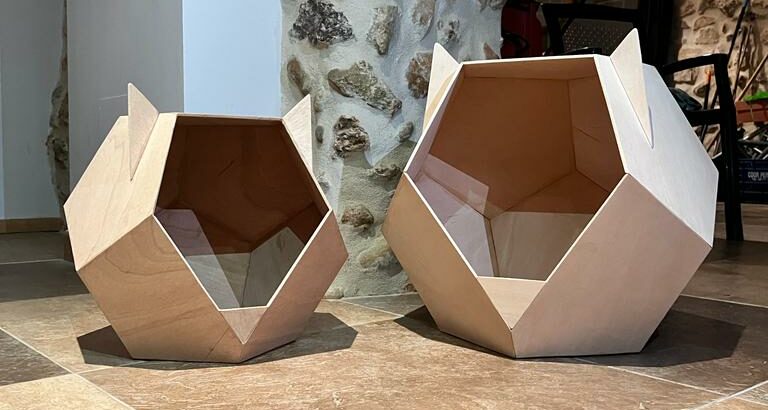Cats tend to be curious, free-spirited cats who enjoy discovering the world around them. Logic would say that if you vaccinate, and keep your cat indoors and away from other cats other than those in the home (like other household cats), your cat stands a low risk of being infected. But, outdoor escapades do not come risk-free, and being able to offer your cat a safe, warm refuge from the winter elements is crucial to their health and safety. That’s where an outdoor cat house comes into play.
Outdoor cat houses offer a safe outdoor shelter for cats when they’re outside, which can be affected by changing weather. Whether it’s snowing and cold, or hot and raining, a well-constructed outdoor cat house keeps your furry friend safe for all seasons. In this post, we’ll review the many advantages of outdoor cat houses and help you verify that it makes sense to shell out a small chunk of change on a cat house that gives you peace of mind, knowing that your animal is well taken care of throughout the year.
The Importance of Shelter for Outdoor Cats
Cats might come across as rugged, go-it-alone animals, but they are susceptible to weather extremes and environmental dangers. When cats are let outside to roam on their own, the risks are clear and stark.
- Cold temperatures and frostbite in winter
- Overheating and dehydration during summer
- Exposure to rain, wind, and storms
- Threats from predators or territorial animals
Outdoor cat houses are meant to help protect your lovely pets against such dangers that may hurt your pets, it offers your cat a safe and comfortable shelter, so as to ensure its safety and health. And whether your cat is the occasional indoor-outdoor adventurer, or a fully outdoor cat, having a safe, warm place to call home is significant to your pet’s well-being.
Benefits of Outdoor Cat Houses in Winter
Outdoor cats may find the winter to be especially difficult. Cats have a hard time regulating their body heat, and prolonged exposure to the cold can cause hypothermia and frostbite. Cat houses made for outdoor winter use provide vital protection:
- Insulation for Warmth: Some of the best cat houses are insulated by some form of Styrofoam, thermal fabric, or double walls that capture heat and keep the cat house warm and inviting.
- Heated Elements: Some designs come with heated pads or are made with self-warming materials that radiate your cat’s body heat back to them, helping them stay warm in cold weather.
- Wind and Snow Protection: The raised floor design, with weather flap and inclined roof functions to keep moisture out from directly entering the outdoor cat house while protecting your cat from snow and wind.
With a warm, secure place to rest, your cat will get through even the coldest days of winter without a cold.
Benefits of Outdoor Cat Houses in Summer
Outdoor cat shelters are not just for winter, though. In the warmer months, they offer necessary shade and ventilation to help your cat stay cool and comfortable:
- UV Protection: Numerous of cat houses are made of UV-resistant material which blocks unsafe rays and shades the interior when warm.
- Ventilation Features: Vents, Open-Door, or Mesh-Body Panels to promote airflow to help prevent overheating and heatstroke.
- Elevated Design: Raised floors keep warmth up off the ground and away from your pets as they sleep inside the house.
Specially designed for summer, outdoor cat houses can protect your cat from heat stroke and dehydration, allowing your pet a safe place to rest in the scorching summer.
Year-Round Protection from Rain and Wind
Rain, thunderstorms, and gusty winds can also make outdoor living quite unpredictable for cats. An outdoor cat house that is properly insulated from damp and chills:
- Waterproof Materials: The best outdoor cat houses have waterproof materials such as treated wood, plastic, and waterproof fabrics that won’t allow water to seep in.
- Elevated Flooring: By keeping the inside high and dryno standing water on the flooryour dog is safe from both inclement weather and even the critters in the yard.
- Sealed Construction: Tightly sealed seams and weather flaps on doors prevent rain from entering, ensuring a dry and cozy space for your cat.
Whether summer, winter, or any time in-between, it’s always a fraction warmer in this little heated space and your cat will be glad of it when in need of some comfort from the elements.
Key Features to Look for in an Outdoor Cat House
When picking an outdoor cat house, it is essential to settle for a model that keeps durability, comfort, and safety into consideration. Here are a few fe atures to look for:
- Insulation: If you’re in a cooler climate, you’ll want to make sure your home is properly insulated so you can keep in all of that heat.
- Weatherproof Design: Look for materials and design that will withstand rain, wind, and UV exposure
- Size: Your cat house should be big enough to allow your cat to move around freely, but no so big that it can lose heat during the colder seasons of the year.
- Easy Access: With a removable roof or a front large door opening for quick and easy cleaning.
- Multiple Exits: Another exit allows a way out for your cat if a threat or other animal enters.
- Stable Base: A raised floor provides a dry, warm, sheltered pet sleeping or nesting space.
- Comfort Features: Bedding, self-warming pads, and warmers offer additional comfort.
Helping Feral and Stray Cats with Outdoor Cat Houses
Outdoor cat houses are not just for your pet, they can also assist community cats. Feral and stray cats have difficulty obtaining safe, dry shelter, even in calm weather. By offering outdoor cat shelter or outdoor cat houses within your yard you are giving these cats the chance to survive. A number of animal welfare groups and volunteers make and place outdoor shelters with TNR programs to improve quality of life for wild cats.
Encouraging Your Cat to Use an Outdoor Cat House
Your feline friend may need some time and encouragement to use a new outdoor cat house. Here are some suggestions for how to ease the transition:
- Place the House Strategically: Select a private, quiet spot that isn’t exposed to lots of human or animal traffic and noise.
- Use Familiar Scents: Add your cat’s preferred blanket, toy, or an item of clothing that has your scent in the carrier to help make it feel at home.
- Reward Curiosity: Scatter treats or catnip around the house so your cat wants to explore.
- Allow Time: Don’t force your cat to explore the house right away.
With some encouragement and positive reinforcement, most cats will cheerfully make it their new retreat.
Conclusion
Protect your cat in all seasons. Not only do these structures protect from cold, heat, and rain, they also offer warm and cosy beds for your kitty to relax on while offering a refuge horse from the hot or cold outdoor temperatures. Whether you’re taking care of your furry friends or trying to help community cats, an outdoor cat house is a worthwhile investment towards their health and protection. With well-planned design elements and precise placement, your cat can enjoy the very best of the outdoors and remain safe from the elements. With your love and care and a great quality outdoor cat house, your cat will be comfortable all year round.



